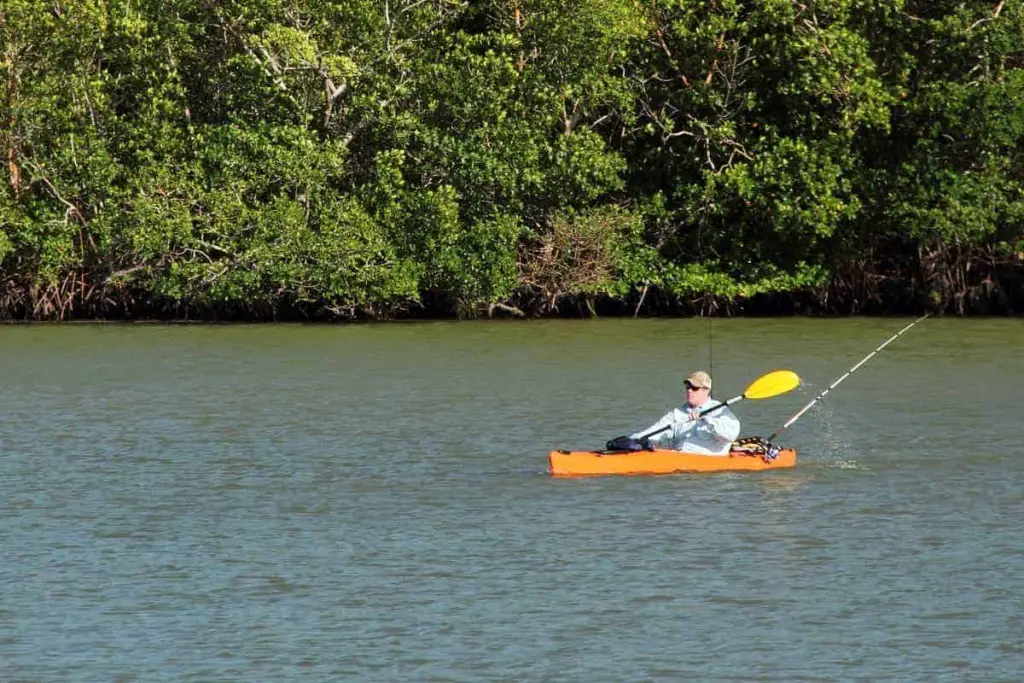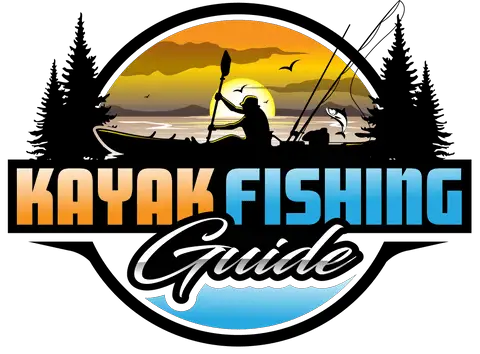
A common question when kayak fishing is, how much anchor line does one need? The answer, like in many instances, is; it all depends. Many of the kayak gear companies will repeat the Boating Industry-standard Rule of Thumb ratio of 7:1 is needed. 7′ of the line for every foot of depth you’re anchoring in. The issue here is, this ratio is commonly given and intended for boats and larger watercraft, not kayaks specifically.
For a fishing kayak, having 3 to 5 times the depth of water in anchor line will accommodate the most common anchoring situations. So in 10′ of water, having between 30′ to 50′ would be adequate. If you’re in very windy or high current conditions, having more anchor line out is preferable.
Let’s take a quick look at the different variables that can come into play when attempting to anchor your kayak.
- Weight of your kayak and gear
- Windy conditions
- Strong currents
- Anchoring in lakes, rivers, and saltwater
Kayak Weight with You and Your Gear
A fishing kayak for a larger person can weigh from 62 lbs up to 118 lbs (Kayak Fishing Guide article: Helpful Guide: Kayak Weight Limits Explained for Larger Anglers). When you add in the additional gear and tackle you may bring along, plus your body weight, the weight of the kayak can be as high as 400 lbs or more! Compare that to an average 16′ fishing boat with a dry weight of 1194 lbs. Add in another 1,200 lbs for people and gear, and you’re close to 2,400 lbs! (Pro Guide V-16 TrackerBoats.com)
A fully loaded kayak will weigh significantly less than the average fishing boat, thus, requiring less rope to hold it in place. The reason being, there is less weight pulling on the anchor line. So the 7:1 ratio of rope length to the depth of water will not equate to the kayak as it does to larger watercraft, and you can anchor and secure your kayak with less anchor line out.
With a lighter weight kayak creating less pull on the anchor line, you’ll be using less rope, and your overall anchor system will be easier to manage.
Dealing With Windy Conditions
When you’re out on the water, and the wind is picking up, there are times you want to drop an anchor. Having extra length on your anchor line will come in handy then. The longer line will allow the anchor to dig into the bottom at a better angle.
The windier it becomes, the more difficult it will be to maintain your spot. With shifting winds and a longer anchor line out, you’ll be at the mercy of the shifting winds. You may find yourself swinging into the shoreline or out into deeper water off your fishing spot.
It is during these windy conditions while having an anchor set out, you’ll want to have a good trolley anchor system installed to manage the line in the kayak. Another item to have on hand is a quality safety rescue knife designed for the water.
An anchor trolley system will allow you to adjust your anchor line to your kayak anywhere from the bow to the stern! If you have anchor rope coiled inside of your kayak and the wind shifts or you get a loop caught on a rod holder or pedal, having a rescue knife handy can save your life!
For more information on anchor trolleys:
How to Use The Wind to Kayak Fish
Now here’s a great fishing tip I learned when fishing in the Boundary Water Canoe Area of Ely, Minnesota in windy conditions! Find a section of shoreline where the wind is blowing parallel to the shore. Paddle upwind and out from the shore a certain distance. Then allow the wind to “drift” you back down the shoreline! If you’re trolling for walleye or other target fish, after your “drift”, paddle back up and move out a few feet further.
By continually move out a few feet at a time with each “drift”, you’ll be fishing a little deeper water with each move! Continue this technique until you find what depth the fish are holding! For those of you without a fish finder, this is an excellent fishing strategy tip!
Strong or High Current Situations
Kayak fishing in a strong or high current situation poses its own unique set of problems. Unless you’re an experienced kayaker, I’d highly recommend staying out of these potentially dangerous conditions.
With small pieces of seaweed and other debris drifting below, dropping an anchor line can be dangerous. Seaweed starts building up on the line and creates a dragging force that can pull your kayak down! Having plant matter or other debris catching on your anchor line can also make it hard to pull up!
Use a Buoy on Your Anchor Line in Currents
When you absolutely must drop an anchor in strong or high current situations, attach an anchor-buoy to your line and clip to that! Hooking that monster fish and having the ability to unclip from your anchor and freely fight the fish can make a huge difference.
Aside from just making it easier to fight and play a fish, if you’re anchored in a strong current and a large fish hooks up, you may find yourself broadside to the current and possibly be pulled under!
An anchor-buoy makes it a quick and easy way to release your kayak from the anchor line when you need to. Once you’re ready to return, simply paddle up to the buoy and reattach your kayak!
What Type of Line for a Kayak Anchor
Use whatever type of rope you have handy for your kayak fishing! I’ve seen just about everything used from heavy fishing lines to clothesline rope! Whether you’re fishing in deep water offshore in a couple of hundred feet of water, in a shallow bay, or a small river or stream, choose the appropriate rope and length for your job.
When fishing offshore or in rocky bottom areas, I’d recommend attaching a chain about three feet long to your anchor and then attach the chain to your rope. The chain will keep your anchor rope from fraying and also give it additional weight to keep your anchor in a good holding position.
My Anchor Line of Choice
I fish primarily lakes, and small streams and rivers. So the line I use will not necessarily be the type of line you’ll use! On days I choose to anchor up I use a 3/16ths nylon rope which is 75′ long.
Related Article: How to Outfit a Kayak for Fishing: The Ultimate Guide
Using a nylon rope, you’ll find it has a bit of stretch to it and will absorb the shock of small waves, gusts of wind, etc. It is light, flexible, and has good strength for its size. Plus, it sinks, so it will not float on top of the water and get into your way!
Attaching Your Anchor Line
One way to attach your anchor line to your kayak is with the use of a couple of cleats! Having a cleat on the bow and stern of your kayak offers you a could of ways of tying off the rope to your kayak.
Using an anchor trolley system to attach your line to your kayak offers the most advantages! A trolley system allows you to connect your anchor line to a ring, and you can pull your line to the bow or the stern of the kayak when needed.
A Quick Tip to Attach the Anchor to the Line
When your anchor becomes stuck on the bottom, and believe me it will from time to time, getting it back can be a chore! Here’s a quick tip to getting your anchor back!
When attaching your line to your anchor, first tie the line to the bottom of the anchor. Lay the line up to the top of the anchor and using a zip-tie or length of strong fishing line, attach the rope to the top of the anchor.
If the anchor becomes hung up or stuck to the bottom, a couple of hard tugs should break the zip-tie or fishing line, and now you can pull the anchor upside down back to you!
Summing it up, the length of anchor line will vary considering your fishing conditions, and the depth of water you’re fishing in. As always, keep safety in mind when dropping an anchor, stay aware of your surroundings and conditions, carry a sharp water rescue knife with you, and have it in easy reach!
Stay safe and enjoy!
